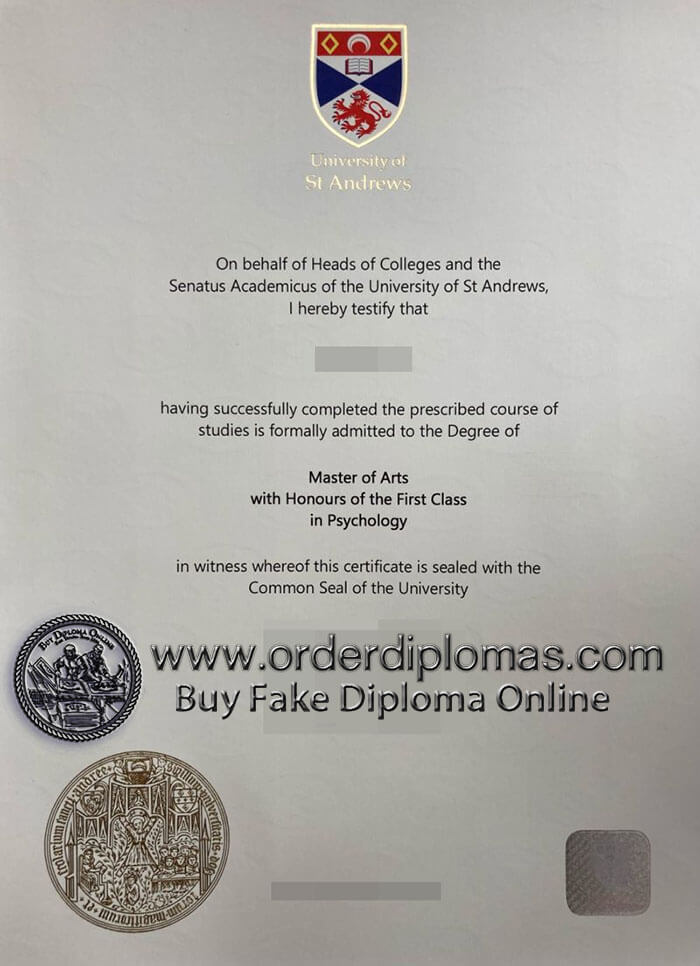
buy fake University of St Andrews degree
How to buy a fake University of St Andrews diploma? how to buy a fake University of St Andrews degree? how to buy a fake University of St Andrews certificate? buy fake University of St Andrews degree, buy fake University of St Andrews diploma
The University of St Andrews (Scots: University o St Andras, Scottish Gaelic: Oilthigh Chill Rìmhinn; abbreviated as St And, from the Latin Sancti Andreae, in post-nominals) is a public university in St Andrews, Fife, Scotland. It is the oldest of the four ancient universities of Scotland and, following Oxford and Cambridge universities, the third-oldest university in the English-speaking world. St Andrews was founded in 1413 when the Avignon Antipope Benedict XIII issued a papal bull to a small founding group of Augustinian clergy. Along with the universities of Glasgow, Edinburgh, and Aberdeen, St Andrews was part of the Scottish Enlightenment during the 18th century. buy fake diploma, order fake diploma.
St Andrews is made up of a variety of institutions, comprising three colleges — United College (a union of St Salvator’s and St Leonard’s Colleges), St Mary’s College, and St Leonard’s College, the last named being a non-statutory revival of St Leonard’s as a post-graduate society. There are 18 academic schools organised into four faculties. The university occupies historic and modern buildings located throughout the town. The academic year is divided into two semesters, Martinmas and Candlemas. In term time, over one-third of the town’s population are either staff members or students of the university. The student body is notably diverse: over 145 nationalities are represented with 45% of its intake from countries outside the UK; about one-eighth of the students are from the EU and the remaining third are from overseas—15% from North America alone. The university’s sport teams compete in BUCS competitions, and the student body is known for preserving ancient traditions such as Raisin Weekend, May Dip, and the wearing of distinctive academic dress.
It has been twice named “University of the Year” by The Times and Sunday Times’ Good University Guide, one of only two UK universities to achieve this. In 2021, St Andrews had highest entry standard of undergraduate admission in the UK, attaining an average UCAS Entry Tariff of 208 points. St Andrews has many notable alumni and affiliated faculty, including eminent mathematicians, scientists, theologians, philosophers, and politicians. Recent alumni include the former First Minister of Scotland Alex Salmond; Cabinet Secretary and Head of the Civil Service Mark Sedwill; Chief of the Secret Intelligence Service (MI6) Alex Younger; former Secretary of State for Defence Sir Michael Fallon; Olympic cycling gold medalist Chris Hoy; Permanent Representative of the United Kingdom to the United Nations and former British Ambassador to China (2015-2020) Dame Barbara Woodward; author Alistair Reynolds and royals Prince William, Duke of Cambridge, and Catherine, Duchess of Cambridge. Five Nobel Laureates are among St Andrews’ alumni and former staff: three in Chemistry and two in Physiology or Medicine.
The university was founded in 1410 when a group of Augustinian clergy, driven from the University of Paris by the Avignon schism and from the universities of Oxford and Cambridge by the Anglo-Scottish Wars, formed a society of higher learning in St Andrews, which offered courses of lectures in divinity, logic, philosophy, and law. A charter of privilege was bestowed upon the society of masters and scholars by the Bishop of St Andrews, Henry Wardlaw, on 28 February 1411. Wardlaw then successfully petitioned the Avignon Pope Benedict XIII to grant the school university status by issuing a series of papal bulls, which followed on 28 August 1413. King James I of Scotland confirmed the charter of the university in 1432. Subsequent kings supported the university, with King James V of Scotland “confirming privileges of the university” in 1532.
A college of theology and arts, called St John’s College, was founded in 1418 by Robert of Montrose and Lawrence of Lindores. St Salvator’s College was established in 1450 by Bishop James Kennedy. St Leonard’s College was founded in 1511 by Archbishop Alexander Stewart, who intended it to have a far more monastic character than either of the other colleges. St John’s College was refounded by Cardinal James Beaton under the name St Mary’s College in 1538 for the study of divinity and law. It was intended to encourage traditional Catholic teachings in opposition to the emerging Scottish Reformation, but once Scotland had formally split with the Papacy in 1560, it became a teaching institution for Protestant clergy. At its foundation in 1538 St Mary’s was intended to be a College for instruction in Divinity, Law, and Medicine, as well as in Arts, but its career on this extensive scale was short-lived. Under a new foundation and erection, confirmed by Parliament in 1579, it was set apart for the study of Theology only, and it has remained a Divinity College ever since.
Some university buildings that date from this period are still in use today, such as St Salvator’s Chapel, St Leonard’s College Chapel and St Mary’s College quadrangle. At this time, the majority of the teaching was of a religious nature and was conducted by clerics associated with the cathedral.

 USA Diplomas
USA Diplomas Canada Diplomas
Canada Diplomas UK Diplomas
UK Diplomas Australia Diplomas
Australia Diplomas Germany Diplomas
Germany Diplomas Malaysia Diplomas
Malaysia Diplomas Singapore Diplomas
Singapore Diplomas Other countries
Other countries Transcript-Form.xlsx
Transcript-Form.xlsx
